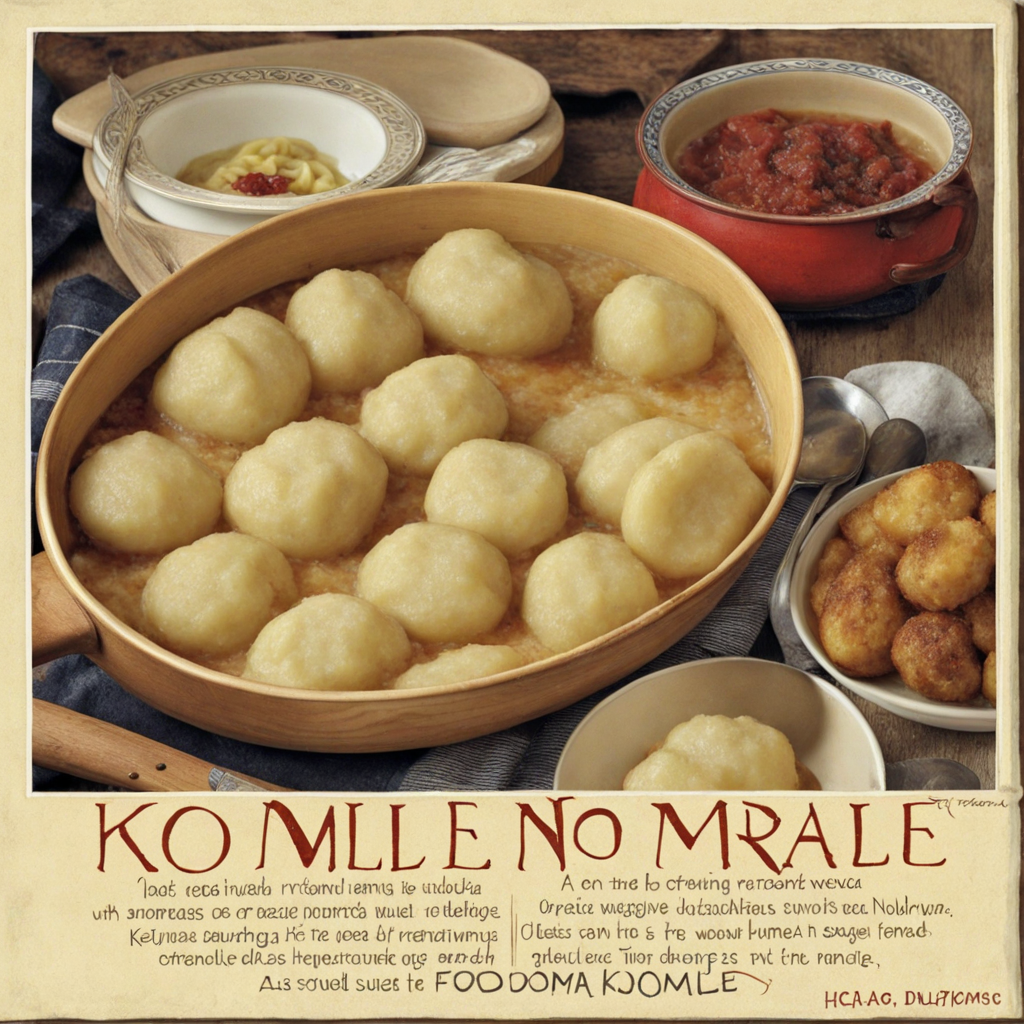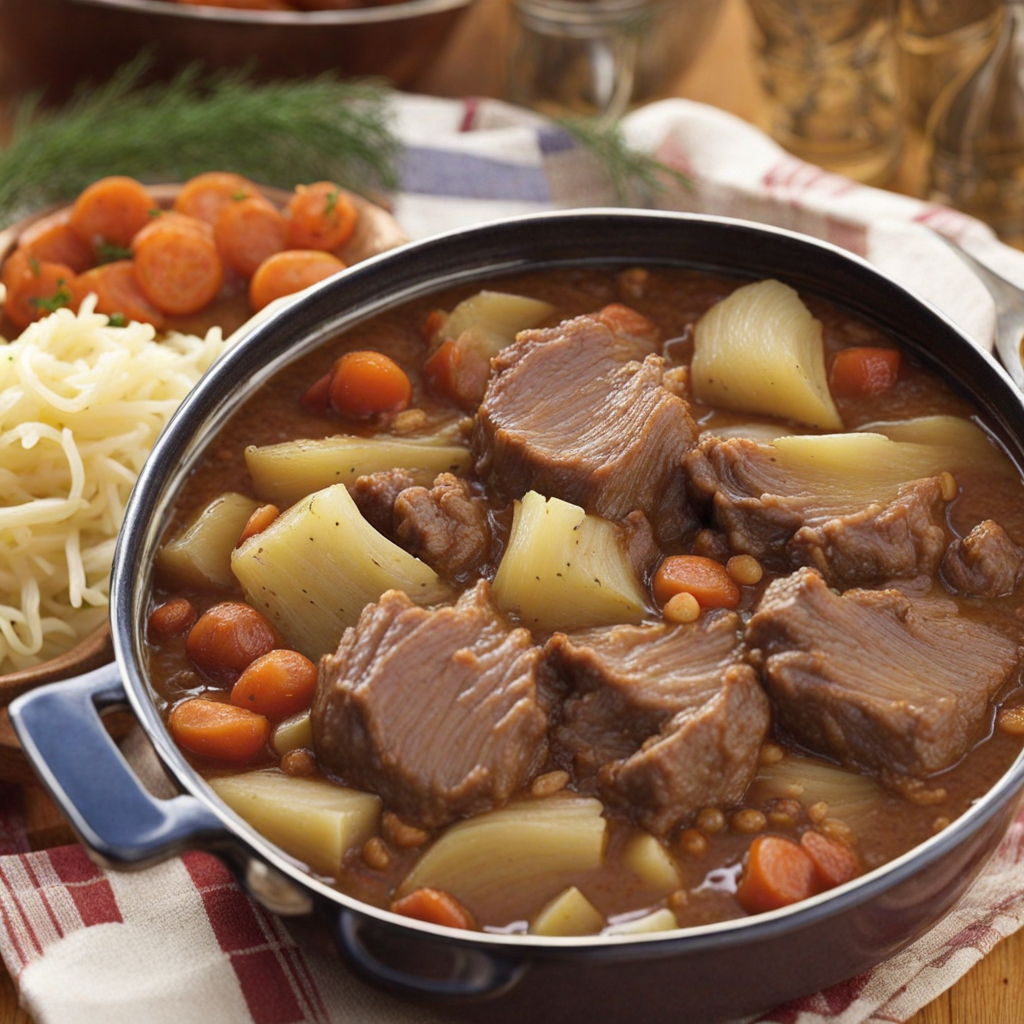Komle
Komle, also known as "potetkomle" or "potato dumplings," is a traditional Norwegian dish that highlights the country's love for hearty, comforting fare. These dumplings are primarily made from grated or mashed potatoes mixed with flour, creating a dense yet tender texture that is both satisfying and filling. Typically shaped into balls or discs, komle can be steamed or boiled, allowing them to retain their natural flavors while absorbing the essence of the ingredients they are paired with. One of the most delightful aspects of komle is its versatility. While the base recipe remains consistent, it can be accompanied by a variety of fillings, such as seasoned meat, bacon, or even vegetables, adding depth and richness to each bite. Served with a side of melted butter, sour cream, or a tangy sauce, komle invites diners to explore a range of flavors that complement its starchy foundation. The dish is often enjoyed during festive occasions and gatherings, making it a beloved staple in Norwegian cuisine. When you take a bite of komle, you'll experience a comforting warmth that reflects the rugged landscapes and cozy homes of Norway. The subtle potato flavor is enhanced by the accompanying sauces, while the chewy texture offers a satisfying contrast. Whether you are enjoying it at a traditional Norwegian restaurant or trying your hand at making it at home, komle promises to introduce you to a unique taste that embodies the heart of Norwegian culinary tradition.
How It Became This Dish
The History of Komle: A Taste of Norwegian Tradition Introduction Komle, also known as “klippfisk” or “potetkomle,” is a traditional Norwegian dish that embodies the essence of Norwegian culinary heritage. This potato dumpling, often stuffed with a variety of meats or served alongside rich stews, has a rich history that intertwines with Norway's geography, culture, and agricultural practices. The evolution of komle reflects not only the ingenuity of the Norwegian people but also their resilience in the face of harsh climatic conditions. Origins of Komle The roots of komle can be traced back to the rural communities of Norway, particularly in the western regions where potatoes were introduced in the late 18th century. Prior to the potato’s arrival, Norwegians relied heavily on grains, fish, and root vegetables. The incorporation of potatoes into the Norwegian diet marked a significant shift, as they provided a more substantial and versatile food source. The word "komle" itself has uncertain etymology, but it is believed to derive from the Old Norse word “koma,” which means "to come together." This is fitting, as the dish is often served at gatherings and feasts. The earliest references to potato dumplings in Norwegian literature appear in the 19th century, suggesting that the dish began to gain popularity as potatoes became more widely cultivated. Cultural Significance Komle is more than just a meal; it is a symbol of Norwegian identity and tradition. It is often served during festive occasions, family gatherings, and holidays, particularly at Christmas and Easter. The dish is a comfort food, evoking nostalgia and a sense of home for many Norwegians. In rural areas, komle was traditionally made from leftover scraps of meat, making it an economical way to utilize available resources. This practice reflects the Norwegian value of frugality and resourcefulness, characteristics that have been essential for survival in the often harsh Scandinavian climate. In addition to its role in everyday life, komle is also associated with various regional variations, showcasing the diversity of Norwegian cuisine. Each region has its own take on the dish, influenced by local ingredients and traditions. For instance, in the coastal areas, komle may be made with fish, while in the inland regions, it might be more meat-centric. Development Over Time As Norway underwent significant social and economic changes in the 19th and 20th centuries, so too did komle. The Industrial Revolution and the subsequent urban migration led to a decline in traditional farming practices, resulting in altered eating habits. However, the love for komle remained strong, and it began to be adapted to modern tastes and lifestyles. The post-war era saw a resurgence of interest in traditional Norwegian cuisine, as people sought to reconnect with their cultural roots. This movement was part of a broader trend in many countries, where there was a growing appreciation for local and homemade foods. Cookbooks featuring traditional recipes began to circulate, bringing dishes like komle back into the public eye. In recent years, komle has enjoyed a renaissance, with chefs and food enthusiasts experimenting with the dish in innovative ways. While traditional recipes remain popular, contemporary interpretations have emerged, incorporating modern culinary techniques and ingredients. Some chefs have begun to use gourmet fillings, such as truffle-infused meats or artisanal cheeses, providing a new twist on this classic dish. Regional Variations Norway's diverse geography has resulted in a variety of komle recipes, each with its own unique characteristics. In the northern regions, for example, komle is often enjoyed with a side of rich meat stews, while in southern Norway, it may be served with a lighter broth or as part of a larger meal. One of the most notable regional variations is the “komle med kjøtt” (komle with meat), which involves stuffing the dumplings with a mixture of meats, such as pork, beef, or lamb. This variation is particularly popular in the western fjords, where livestock farming has a long-standing tradition. In addition, the use of local herbs and spices can greatly influence the flavor profile of komle across different regions. For instance, in Northern Norway, it is common to add juniper berries for a unique aromatic touch, while in the South, dill might be favored. Modern-Day Komle Today, komle continues to hold a cherished place in the hearts of many Norwegians. It is often featured on restaurant menus, especially in establishments that focus on traditional Norwegian cuisine. Food festivals celebrating local produce and heritage have also contributed to a renewed interest in the dish, with various regional competitions showcasing the best komle prepared by local chefs. Moreover, as global travel and cuisine continue to influence culinary practices, komle has found its way into the homes of food lovers around the world. Social media platforms have enabled food enthusiasts to share their own takes on the dish, encouraging cross-cultural exchanges and inspiring creativity in the kitchen. Conclusion Komle is a testament to Norway's rich culinary history, embodying the resilience, creativity, and cultural significance of the Norwegian people. Its evolution from a humble potato dumpling to a cherished traditional dish reflects the broader narrative of Norway’s agricultural progress, social changes, and regional diversity. As komle continues to adapt and thrive in modern gastronomy, it remains a delicious reminder of Norway's heritage, connecting generations through the simple joy of good food. Whether enjoyed at a family gathering or celebrated at a food festival, komle carries with it the spirit of Norway, inviting all to savor its flavors and stories.
You may like
Discover local flavors from Norway







